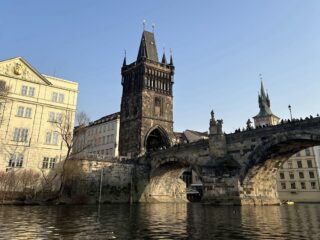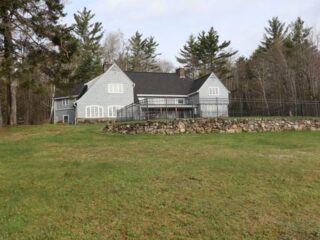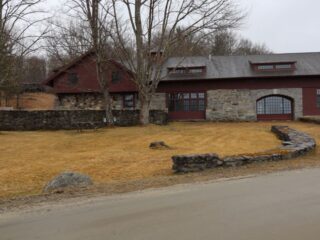Rokeby in Ferrisburgh is first on my list for high quality, fascinating small house museums in my home state of Vermont. It’s near my home; it’s a beautiful late eighteenth century Vermont cape house; and it was home to a writer, Rowland Evans Robinson, and several painters, including his daughter, Rachael Robinson Elmer, nationally-known for her postcard designs.
The Robinson homestead was called Rokeby after a poem by Sir Walter Scott and after a manor in the north of England. Rokeby means a settlement of crows. Four generations of artistic, farming (mostly) Quakers lived there. The brown clapboard house is originally furnished: full of paintings (mostly done by family members), books, china and linens, and musical instruments. The Robinsons raised sheep and later dairy cows, and this was the only documented stop on the Underground Railway in Vermont. Most of the family were staunch abolitionists. In 1997, the property celebrated its official designation as a National Historic Landmark. Aside from the main house, eight agricultural out-buildings, small barns, a chicken coop, several foundations, wells and a sheep dip are open for visitors to explore.
Rowland Evans Robinson, born May 14, 1833 at Rokeby (he died in 1900 at Rokeby), is known as an illustrator and a writer, with several books to his name. Some of his more famous titles are Uncle Lisha’s Shop, A Danvis Pioneer, Danvis Folks, and In New England Fields and Woods. He also wrote regularly for magazines such as Forest and Stream and The Atlantic Monthly. His illustrations appeared in Moore’s Rural New Yorker; Forest and Stream; Youth’s Companion; Shooting and Fishing, and other periodicals of the day. Also a historian, Robinson wrote Vermont: A Study of Independence and A Hero of Ticonderoga, among other titles.
Robinson is considered by many critics to be a regionalist and a folklorist. He was a conservationist. He wrote in long sentences with lots of precise natural description, and his characters often speak in a phonetic language made up of four dialects. Critic Ronald L. Baker, in his book, Folklore in the Writings of Rowland E. Robinson, enumerates the author’s inspirations: “the tall tales, hunting yarns, village anecdotes, and place legends that swirled through Ferrisburgh.”
Robinson was also a painter, especially of agricultural and hunting scenes. Many of his paintings hang in the house: scenes of winter, of foxes and of hunting. His wife, Anna, was a painter and art teacher, took her husband’s book dictation when he became blind later in life, and worked as town clerk of Ferrisburgh. Reading, writing, conversation, music and making art were valued highly in this family, which had three children.
Although most visitors are primarily interested in Rowland Robinson’s work and thoughts, I am most strongly drawn to his daughter, Rachael, born in 1878. Unlike many women at that time in rural areas, Rachael and her sister, Mary, were allowed to become who they wanted to be. For both these women, this meant being an artist. Rachael was to become the more famous for her paintings, her children’s textbooks illustrations, her book cover designs and her artistic postcards of New York City.
Rachael’s father bought her sketchbooks, which were not inexpensive at the time, beginning when she was eight, notes Ray Hahn, a collector of her work. She always had a great deal of encouragement, he explains. At the age of twelve, Rachael enrolled in a correspondence art course entitled the Chautauqua Society of Fine Arts in addition to completing her regular school work. Ernest Knaufft, the director of the art program, realized, that, by the age of fourteen, she had great potential. He wrote her mother that Rachael was more talented than most of his thousands of other students and invited Rachael to come to New York to study in his life class. For three years, the teenage girl spent a month or more in New York, drawing from live models and becoming more sophisticated.
When she was sixteen, she entered the Goddard Seminary, a boarding school in Barre,Vermont. When she left home, her parents were bereft, especially as Rowland had become totally blind a year earlier, after a long period of diminishing sight. But the family members were prolific, often daily, letter writers; many of those letters are temporarily housed in the Stewart-Swift Research Center of the Sheldon Museum in Middlebury, Vermont.
After she graduated from Goddard Seminary at eighteen, Rachael taught art students at her home and also in Burlington. She taught painting and drawing classes at Goddard and, as an associate editor, contributed prose and poetry to The Goddard Record. Like her father, she often wrote about nature.
Her parents were not entirely in favor of her teaching; they thought she should pay more attention to her schoolwork and especially to her drawing. In January 1895, her father wrote her, Remember that a few things well done are better than many half done… Thee is not at school for pleasure, but for improvement…I do hope thee will not neglect thy drawing. (Sheldon Museum collection)
For three winters beginning in 1898, she studied at the Art Students League of New York, under the Impressionist artist Childe Hassam, John Henry Twachtman and others. Kenyon Cox, Howard Pyle, Appleton Clark, and George de Forrest Brush also taught there.
Her goal was to become a commercial artist, so Rachael moved to New York and began work for a firm called Decorative Designers (D.D.S.), for whom she designed and executed book covers. She provided illustrations for magazines including Youths Companion and for prominent publishers, including E.P. Dutton, Harper and Brothers, Little Brown & Company and the American Book Company, which published textbooks. At first, she always signed her work with her trademark signature, two Rs back to back. Later, she sometimes wrote out her maiden name and later added her married name, Elmer, to her signature.
Her designs – on postcards or on children’s book covers are now collectible, as are her father’s books. Sadly, Rowland E. Robinson’s books are out of print, although a couple of modern editions have been printed. Vermont poet, David Budbill, had an abridged edition of Robinson’s work published in 1994.
The Rokeby museum and grounds, with walking trails are located on Route 7 south of Burlington, Vermont. The site is open mid-May to mid-October. The staff provide an excellent tour. In the summer months, the museum holds a popular pie and ice cream social, a wool festival, and a variety of talks and walks. Rokeby, Route 7, Ferrisburgh, Vermont 05456, 802-877-3406.
Deborah Straw is writer who lives in Vermont. Her book, Natural Wonders of the Florida Keys, is available from Country Roads Press, an imprint of NTC Contemporary Publishing Group.








